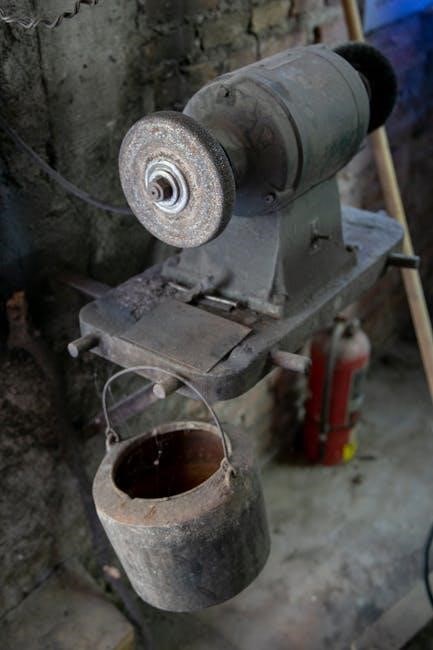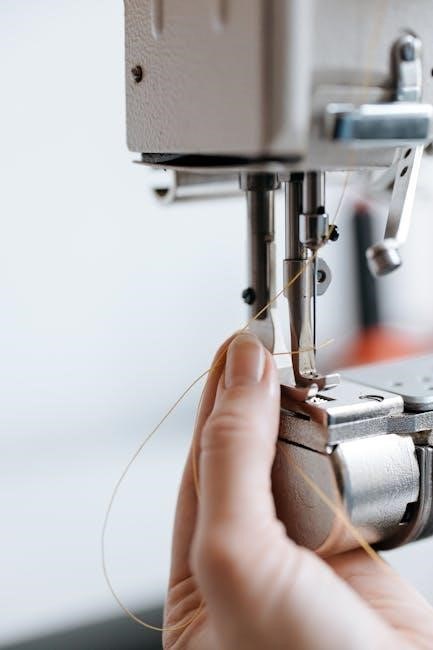Singer Heavy Duty Sewing Machine Manual: A Comprehensive Guide
Welcome to your ultimate resource for mastering your Singer Heavy Duty sewing machine! This guide provides a complete overview, offering everything from basic setup to advanced techniques. Discover how to unleash your machine’s full potential!
Singer Heavy Duty sewing machines are renowned for their robust construction and ability to tackle demanding sewing projects. These machines are designed to handle thick fabrics and multiple layers, making them ideal for both garment alterations and more ambitious creations. With a powerful motor and durable components, they offer a reliable and versatile option for sewists of all skill levels. Whether you’re a beginner or an experienced user, understanding the capabilities of your Singer Heavy Duty machine is key to unlocking its full potential and achieving professional-quality results. Explore the world of heavy-duty sewing!
Understanding Your Singer Heavy Duty Model
Knowing your specific model is crucial. Each Singer Heavy Duty machine has unique features. Identifying your model unlocks access to the correct manual and tailored guidance, ensuring optimal performance and longevity.
Identifying Your Specific Model Number
Locating your Singer Heavy Duty sewing machine’s model number is the first step towards accessing the right resources. This number is typically found on a sticker or plate affixed to the machine’s body. Common locations include the base, the back, or underneath the free arm. The model number often consists of a combination of numbers and letters. Once you have identified the model number, you can find the corresponding manual and information to ensure proper usage and maintenance of your specific machine.
Accessing the Correct Manual
Once you’ve identified your Singer Heavy Duty model number, accessing the correct manual is crucial for optimal use. Start by visiting the official Singer website, where you can search for your manual by model number. If the official website doesn’t have it, explore third-party manual repositories online. Ensure the manual matches your machine’s model to avoid incorrect instructions. Downloading a PDF version allows for easy access on any device, ensuring you always have the information you need at your fingertips. Physical copies can also be obtained.

Key Features and Functions
Understanding your Singer Heavy Duty’s key features is essential. Learn about threading, stitch selection, and presser foot adjustments. Mastering these will unlock your sewing machine’s capabilities and improve project outcomes.
Threading the Needle and Bobbin
Correctly threading the needle and bobbin is crucial for preventing sewing mishaps and achieving quality stitches. Consult your Singer Heavy Duty manual for precise, model-specific instructions. Many models offer an automatic needle threader for added convenience. Ensure the thread is properly seated in the tension discs. Follow the numbered diagrams in your manual step-by-step to avoid tangles and breakage; A properly threaded machine equals smooth sewing and professional results. This process can often feel cumbersome, but practice makes perfect; Always double-check your work, and refer to your manual!
Stitch Selection and Adjustment
Your Singer Heavy Duty offers a range of stitch options for various sewing tasks. Refer to your manual to understand each stitch’s purpose and how to select it. Adjust stitch length and width to suit your fabric and project requirements. Test different settings on a scrap fabric before starting your main project. Understanding the relationship between stitch settings and fabric type is critical for achieving professional results. Consult the manual for recommended settings. Experiment with different combinations to find what works best. Your manual is the key to unlocking your machine’s stitch potential and creative expression.
Adjusting Presser Foot Pressure
Proper presser foot pressure is essential for even fabric feeding. Consult your Singer Heavy Duty manual to locate the presser foot pressure adjustment screw. For delicate fabrics, reduce pressure by turning the screw counter-clockwise. Increase pressure for heavier fabrics by turning it clockwise. Uneven feeding, puckering, or skipped stitches often indicate incorrect pressure. Always test adjustments on a fabric scrap. The manual provides specific guidance for various fabric types. Fine-tuning the presser foot pressure ensures consistent stitch quality and prevents damage to delicate materials. Correct pressure is the key to professional sewing.

Troubleshooting Common Issues
Encountering problems with your Singer Heavy Duty? This section addresses common issues like thread breakage, needle problems, and fabric feeding difficulties. Find solutions to keep your sewing machine running smoothly and efficiently.
Thread Breakage
Thread breakage is a frustrating issue, but often easily resolved. First, ensure you’re using the correct type and weight of thread for your fabric. Check that the needle is properly threaded, following your manual’s diagram precisely. A damaged or burred needle can also cause thread to break; replace it immediately. Verify the thread tension is correctly adjusted; too tight or too loose can both lead to breakage. Clean any lint or dust from the bobbin case and thread path. Lastly, ensure the bobbin is wound evenly and inserted correctly into the machine.
Needle Problems
Experiencing needle issues with your Singer Heavy Duty? Let’s troubleshoot! A bent or broken needle is a common culprit; replace it with the correct type and size for your fabric. Ensure the needle is inserted fully and correctly, with the flat side facing the right direction as indicated in your manual. Double-check that you’re using the appropriate needle for the fabric weight; heavy fabrics require stronger needles. If the needle is skipping stitches, try a new needle or adjust the presser foot pressure. Always unplug your machine before changing the needle for safety.
Fabric Feeding Issues
Is your Singer Heavy Duty struggling to feed fabric smoothly? First, ensure the feed dogs are properly engaged and not set for darning or free-motion quilting. Clean any lint or debris from the feed dogs and needle plate. Check the presser foot pressure; it might be too high or too low for the fabric. For thick fabrics, consider using a walking foot. If the fabric is puckering, try adjusting the stitch length or tension. Ensure you are gently guiding the fabric and not forcing it through the machine. A dull needle can also contribute to feeding problems; replace it if necessary.
Maintenance and Care
Proper maintenance ensures your Singer Heavy Duty operates smoothly for years. Regular cleaning, oiling, and timely replacement of parts are essential. This section details how to keep your machine in top condition.
Cleaning and Oiling
To maintain the optimal performance of your Singer Heavy Duty sewing machine, regular cleaning and oiling are crucial. Begin by unplugging the machine to ensure safety. Use a soft brush to remove lint and dust from the bobbin area, feed dogs, and other accessible parts. Stubborn debris can be dislodged with a lint roller or a small vacuum attachment. Next, apply a few drops of sewing machine oil to the designated oiling points, as indicated in your manual. Wipe away any excess oil to prevent staining your fabrics. Consistent cleaning and oiling will prolong the life of your machine.
Replacing Needles and Other Parts
Maintaining your Singer Heavy Duty sewing machine involves occasional replacement of worn parts. Needles should be changed regularly, approximately every other project, or immediately upon thread breakage or damage. Consult your manual for the correct needle type and size for your fabric. To replace the needle, loosen the needle clamp screw, remove the old needle, and insert the new one with the flat side facing the back. Secure the needle clamp screw tightly. Other parts, such as the bobbin case or presser feet, may also need replacement over time. Refer to your manual for specific instructions and compatible parts.

Downloading and Accessing Manuals Online
Easily access your Singer Heavy Duty sewing machine manual online. Find it on the official Singer website or explore third-party repositories for digital copies. Download and save for convenient reference anytime, anywhere.
Official Singer Website
The most reliable place to find your Singer Heavy Duty sewing machine manual is the official Singer website. Navigate to the “Support” or “Downloads” section and search using your specific model number. Downloading directly from Singer ensures you receive the correct and most up-to-date version of the manual. You can also find helpful FAQs, troubleshooting tips, and accessory information specific to your machine. Ensure you have the correct model number to make the process seamless and efficient.
Third-Party Manual Repositories
If you’re unable to locate your Singer Heavy Duty sewing machine manual on the official Singer website, consider exploring reputable third-party manual repositories. These websites often host a wide variety of manuals for different models, including older or discontinued ones; Be cautious and verify the manual’s authenticity before downloading, ensuring it matches your specific model number. User reviews and ratings can help you assess the reliability of the source. Always scan downloaded files for potential security threats to protect your device.
Utilizing the Manual for Advanced Techniques
Unlock advanced sewing skills! Your Singer Heavy Duty manual provides detailed instructions for techniques like buttonholes, zippers, and working with heavy fabrics. Master these skills to elevate your sewing projects today!
Buttonholes and Zippers
Mastering buttonholes and zippers elevates your sewing projects, adding professional finishing touches. The Singer Heavy Duty manual offers step-by-step guidance, ensuring perfect execution. Explore the specific settings and techniques outlined for your machine model. Achieve consistent, durable buttonholes using the automatic buttonhole feature, if available. For zippers, learn the proper foot attachments and stitching methods for seamless integration. Practice these techniques on scrap fabric to build confidence. With the manual’s help, you’ll create flawless closures every time, adding polish to your garments and crafts.
Working with Heavy Fabrics
The Singer Heavy Duty machine excels when tackling tough materials like denim, canvas, and leather. Consult your manual for optimal settings and techniques. Proper needle selection is crucial; use heavy-duty needles designed for thick fabrics. Adjust the presser foot pressure to ensure even feeding and prevent skipped stitches; Increase stitch length for stronger seams. Consider using a walking foot attachment to further enhance fabric control. Test on scraps first! Slow, steady sewing yields the best results. Your manual provides tailored advice for achieving professional-quality finishes on all your heavy-duty projects, unlocking new creative possibilities.

Finding Accessories and Replacement Parts
Keep your Singer Heavy Duty running smoothly by sourcing genuine accessories and replacement parts. Explore authorized Singer dealers and trusted online retailers for needles, presser feet, and more. Refer to your manual for specific part numbers.
Authorized Singer Dealers
Locating authorized Singer dealers is crucial for obtaining genuine accessories and replacement parts for your Heavy Duty machine. These dealers offer expert advice, ensuring you select the correct components for optimal performance. They often provide warranty support and repair services, offering peace of mind. Purchasing from authorized dealers guarantees quality and compatibility, preventing potential damage from using substandard parts. Check the Singer website for a list of authorized dealers near you to maintain your machine’s integrity and longevity.
Online Retailers
Beyond authorized dealers, numerous online retailers offer Singer Heavy Duty sewing machine accessories and parts. When shopping online, prioritize reputable websites with established customer service and clear return policies. Check product descriptions carefully to ensure compatibility with your specific model. Read customer reviews to gauge the quality and reliability of the products. Be wary of suspiciously low prices, which may indicate counterfeit or substandard items. Online retailers provide convenience and a wide selection, but exercise caution to avoid purchasing incompatible or low-quality components that could harm your machine.
Safety Precautions
Prioritize safety when operating your Singer Heavy Duty sewing machine. Always follow basic safety guidelines to prevent injuries and electrical hazards. Refer to the manual for detailed safety instructions and warnings.
General Sewing Safety
Always keep your work area clean and well-lit to prevent accidents. Ensure the power switch is easily accessible in case of emergencies. Never operate the machine with wet hands or near water to avoid electric shock. Disconnect the machine when changing needles or performing maintenance. Keep fingers away from moving parts, especially the needle. Use the correct needle type for your fabric to prevent breakage. Wear appropriate eye protection. Secure loose clothing and hair to avoid entanglement. Children should be supervised closely when the machine is in use. Read and understand the manual completely.
Electrical Safety
Before plugging in your Singer Heavy Duty sewing machine, verify that the voltage matches your local power supply. Use only the power cord provided by the manufacturer to avoid damage or fire. Never use a damaged power cord. Avoid overloading electrical outlets. Do not immerse the machine or power cord in water or other liquids. Always unplug the machine when not in use or during cleaning. If the machine malfunctions, do not attempt to repair it yourself; seek qualified service. Keep the power cord away from heat sources and sharp edges. Ensure the foot pedal is placed on a dry surface.
